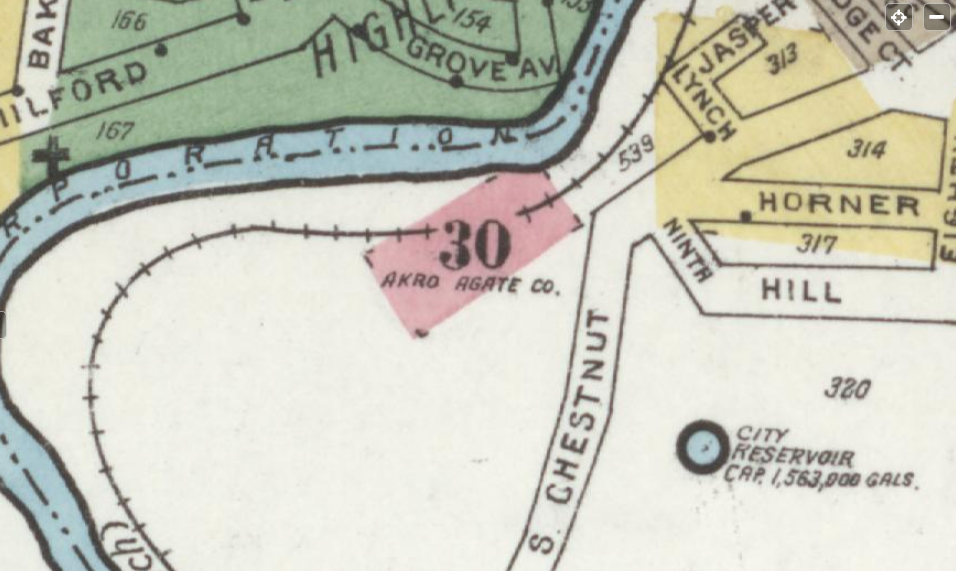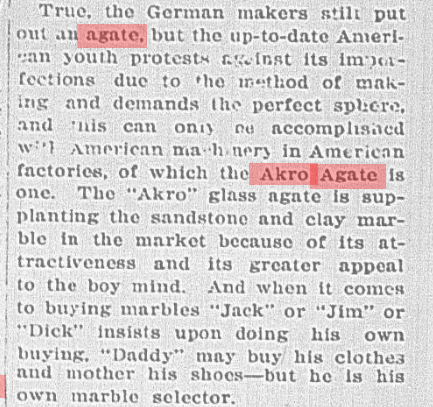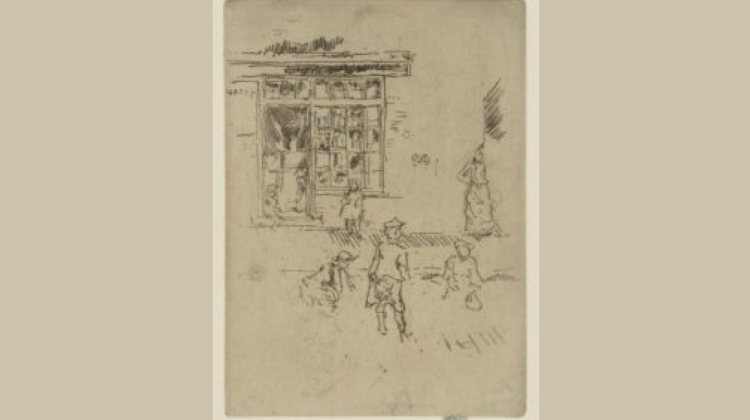
Etching “Marbles” by James McNeill Whistler[1]
https://www.loc.gov/pictures/item/2010648381/
Whistling In The Newspaper Morgue Files
If you have read some of our stories then you know that we enjoy reading old newspapers at the the Library of Congress digital newspaper morgue (https://chroniclingamerica.loc.gov/). The site Chronicling America has a digital American newspaper morgue of all states ranging from 1756 to 1963. We have found some remarkable information in these papers which we have never seen published in books or online sites. We have incorporated information found in the papers into a number of our Posts such as Repeating Torpedo Marbles.
Jest Cruzzin
This story is about some of the little things, the oddments, the brevities which we found recently while checking out these old newspapers. Some of the clippings have hardly enough to allow us to branch out and research further.
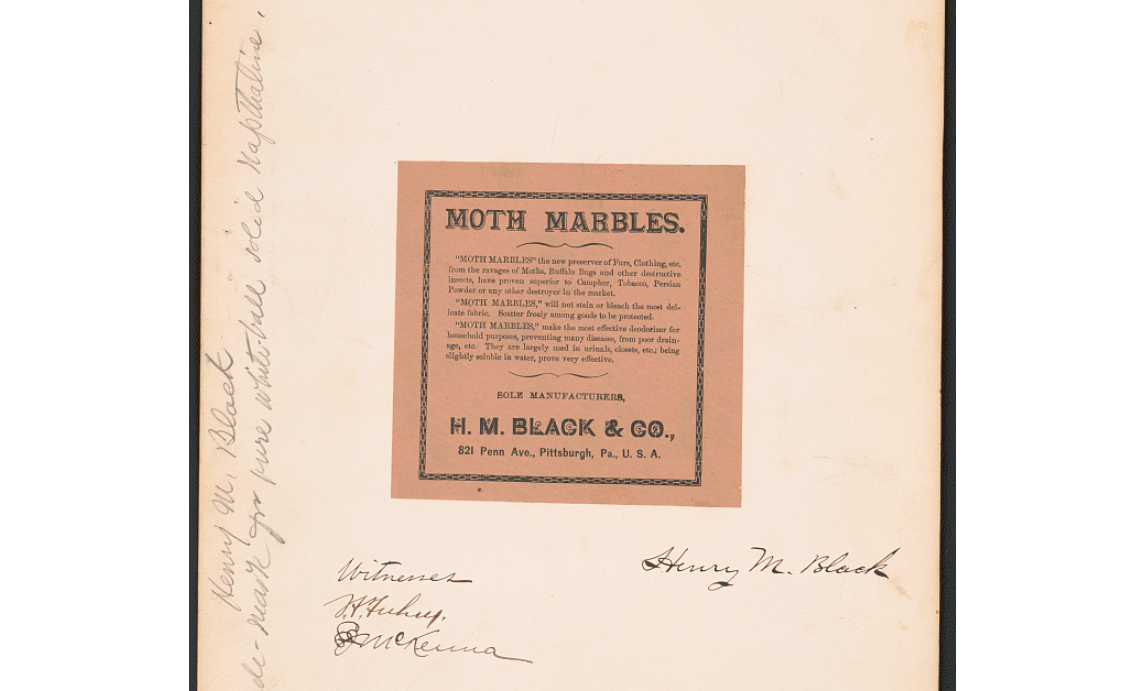
Trademark Registration by H.M. Black for Moth Marbles brand Pure White Ball Solid Naphthaline.
Photograph retrieved from the Library of Congress, www.loc.gov/item/2020710648/
Occasionally clippings are just fragments of larger stories. Some of these early clippings have been used in books and in much longer articles. We see no reason to plow well-plowed ground, but we did want to share a snapshot of some very early stories that many of know so well. Wherever possible we have provided references so if you want you can learn much more about the topic.
And finally some of the clippings seem lost in time and place and we leave them to you to parse. So, let’s have a little fun with some newspaper clippings from a long time ago.
Moth Marbles
We always called these little stinkers “mothballs”. We hardly ever see them anymore although once in a great while we do find a few scattered in the yards of old home places. Do you now or did you ever use the term “moth marbles”? So, What is a moth marble anyway?
The online paper “Mothballs: A Short History & Guide For Use”[2] is very informative:
“In the early 1800’s, certain chemists began to experiment with purified coal tar and the odiferous properties that characterized this white, waxy, solid substance[3]. By 1821, a chemist named John Kidd standardized the production of this chemical, which we know as naphthalene today. Soon after, the famous scientist Michael Faraday… identified the molecular formula of naphthalene, which further established its notoriety in the scientific community.
Experimentation with naphthalene continued over the next several decades, and another substance was eventually developed after it was discovered that burning naphthalene generated significantly large flames. It was through this experimentation that a second active ingredient in mothballs came to be known: paradichlorobenzene. This new substance generated a similar vapor as naphthalene, making it an effective pesticide when used in the correct conditions.
Together, these two chemicals represent the active ingredients in mothballs as we know them today, thanks to years of experimentation in the 19th century by several dedicated scientists.”
Moth Marbles: Regional Terminology?
For a while we thought that the term moth marbles might be colloquial and confined to one particular region. We know it is not a typical British term although considerable experimentation was carried out in 19th century England on various moths and especially the clothes moth.
Well, when we did a quick and incomplete check of old newspapers we found the term in use in fourteen states from Louisiana to Montana; from Colorado to West Virginia. So, it was widely used. We can really see no harm to little boys who might have been curious about the new “marbles”in Grandma’s trunk: the stink alone would cure any interest they may have had in the white marbles.
Buffalo Gnats
It’s hard to read in Black’s Trademark Registration, but his moth marbles are reported to be effective not only against clothes moths, but against Buffalo gnats (Simuliidae) (or black flies) as well.
We once hiked in every state forest in the state of Florida. And black flies, or turkey gnats almost carried us off! The females feed on the blood of mammals, including us, and they prefer to fly and bite around your eyes, ears, nose, and all in your hair.
Remember, when Black was planning on selling his marbles most homes in America had no central heat or air. Windows were kept opened except in harshest winter, and most windows had no screens. Clothes moths and turkey gnats flew inside as well as out! Can you imagine trying to cook or wash up with those creatures having breakfast, lunch, and dinner at your expense? If his moth marbles worked, then we bet Mr. Black became a rich man!
We are told that the tiny bugs are black and they have humps that look like a bison’s hump and thus one of their names. They do eat nectar and any other sugar source that they can find, but females need blood as a food source to lay eggs. Besides hurting like a sting, bites often itch and swell. And you might stay itchy for days.
We read online that these gnats can kill poultry with their toxins and they can even become so numerous that they suffocate the birds.[4] Maybe those mothballs scattered around the yards of old home sites make a lot of sense!
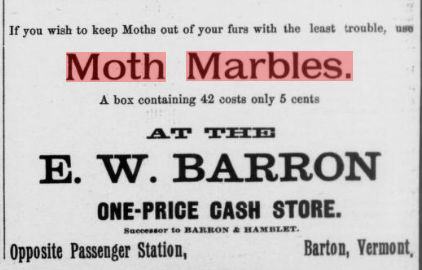 They’re Not Cheap![5]
They’re Not Cheap![5]
This Barton, Vermont advertisement listed them at 42 for 5¢. This is in 1900 and at today’s prices they cost about the equivalent of a little more than $13.00 or about 31¢ each today!
This add was published in late April and the most buggy season in Vermont is in May to late June.
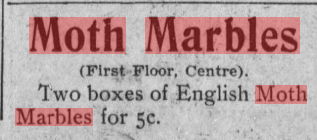 Just Wondering[6]
Just Wondering[6]
We will close out our little foray into moth marbles. Remember, while poison, these little white balls were to be placed adjacent to your clothes when you packed them away into a tightly fitting closet or trunk.
Clothes moths eat animal fibers, especially wool, but also fur, silk, and even feathers, felt, and leather. All of these natural fibers contain keratin which the moth larvae can digest.
We wonder how everything smelled after storing them for a while. In theory you just had to “air them out”. We also wonder about something else. Remember that what kills the moths is highly flammable fumes from naphthalene generated inside a closed-up space. Naphthalene generates “significantly large flames”. Wonder what would happen if Grandpa lit his cigar or pipe much too close to a closed clothes closet?
Anyway, today homes with central heat and air leave no place for the moths to enter the house. Also, in a closet in 1890 – 1915 or so, almost every piece of clothing was made of natural fibers. Moths tend to avoid synthetic fibers like rayon, polyester, and spandex. They will eat all of these, however, if they are blended with wool or if you store them away dirty. And finally, most homes today use some type of regular pest service.
Early Akro-Agate[7]
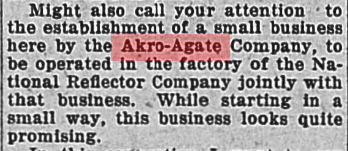
This notation is from The Daily Telegram in Clarksburg, West Virginia, on November 7, 1914.
The paper was published 1901-1926.
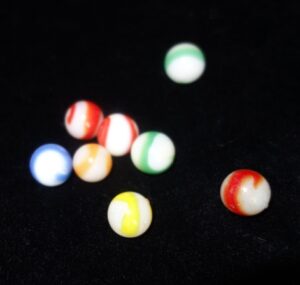 Akro Agate Spirals: Photograph by Jo Garrett[8]
Akro Agate Spirals: Photograph by Jo Garrett[8]
We didn’t know until we read this clip that when Akro-Agate moved to Clarksburg from Akron, Ohio they started out in the same building as National Reflector Company.
While we can’t find the National Reflector Company in a Clarksburg business directory and cannot learn more about them, we do think that we found the reason why Akro moved in with them.
From “The History of the Machine-Made Glass Marble The M.F. Christensen and Son Company and the Akro Agate Company” Chris Cooper writes:[9] “In 1914, the Akro Agate Company moved from Akron, Ohio to Clarksburg, West Virginia where supplies of natural gas and sand were abundant. They had found an old factory that already had its own train spur and loading docks.”
Was that “old factory” the National Reflector Company as noted in The Daily Telegram? We thought so until we continued to research and we found this note: “[Akro Agate] found an existing plant that was vacated. The building formerly housed the ‘National Aluminum Company’”. It was an ideal site, since it was located beside railroad tracks, with a side rail to the building for loading. At this time they rented the building and began operation. “Akro Agate” first appeared in the Clarksburg City Directory in 1915, as manufactures of toy marbles, caster balls, and glass balls for lithographers use.”[10] Akro settled in West Clarksburg on the West Fork River.
Sanborn Fire Insurance Map from Clarksburg, Harrison County, West Virginia. Sanborn Map Company, Jul, 1916. Map.
Retrieved from the Library of Congress, <www.loc.gov/item/sanborn09397_007/>.
Sand, Gas, and The Right Side Of The Tracks
Historically, there were three elements to glass making: silica sand, a source of inexpensive and dependable gas, and railroads. And also historically, good quality silica sand was found in several areas around Clarksburg. One notable location was the Warm Springs Ridge, just north of Berkeley Springs, which was known for its high-quality glass sand. This area saw many small mining operations in the early 1900s, eventually leading to the establishment of the Berkeley Glass Sand Company in 1911.[11]
As for gas, from 1906 to 1917, West Virginia was the leading state in natural gas production in the United States.[12]
And finally, railroads. “The Baltimore and Ohio Railroad [B&O] reached Clarksburg from Grafton [West Virginia] in 1856. The historic district of Clarksburg is mainly outlined by Hewes Avenue on the north, Main Street on the south, Chestnut Street on the west, and E B. Saunders Way [formerly Water Street] on the east.”[13]
We kept studying the 1916 Sanborn map. It looks to us like Akro built right on the B&O trunk line which was named the West Virginia & Pittsburg Branch. This Branch ran from Grafton, WV, to Parkersburg, WV, and it was one link of a long and large rail corridor linking West Virginia to St. Louis and all of the Midwest.

Tunnel 13 on the West Virginia & Pittsburg Branch; Photograph by Jo a Garrett[14]
“Unquestionably were the tunnels that defined the Parkersburg Branch. These were the signature element of the line and embellished its existence as a fascinating section of railroad. Mark Twain referred to it “as the longest subway in the world”. In the later years of the Branch, these tunnels, unique from a rail enthusiast perspective, would prove to be more of a liability.”[15]
Tunnel #13 is on the West Fork River Trail which tracks along the old rail bed. This trail is a part of the Ten Rails-To-Trails in West Virginia.
Goofiness
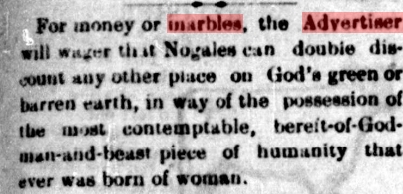
Mohave County Miner. [volume], March 26, 1892, Image 5
About Mohave County miner. [volume] (Mineral Park, A.T. [Ariz.]) 1882-1918
Ok. We’ve puzzled about moth marbles and we have checked out the earliest start in West Virginia of one of the instrumental and superlative marble companies in American history. We will return to Akro in a bit, but we did want you to think about this next clip.
Any idea at all what this means? All we can add is this: “Nogales, Arizona, is about 70 miles south of Tucson and 180 miles south of Phoenix. The cross-border community straddles the international boundary between the U.S. and Mexico with its sister city, Heroica Nogales, Sonora, immediately on the other side. The twin cities are often referred to as Ambos, Nogales, meaning ‘both Nogales.’ The name ‘Nogales’ comes from the Spanish word for walnut, referring to the now-extinct black walnut trees that once dotted the surrounding hills of the cities.”[16]
Who was “the Advertiser”? And why the discontent with Nogales which was about 385 miles overland from Mineral Park, Arizona Territory?
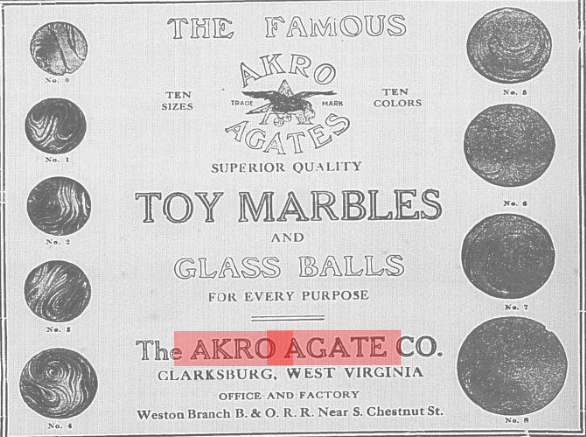
The daily telegram. [volume], November 28, 1916, Page PAGE 33, Image 47
About The daily telegram. [volume] (Clarksburg, W. Va.) 1901-1926
Back to Akro: Ten Colors & Ten Sizes
Did you know this? Can you list ten colors off the top of your head? These colors were popular in 1916; Ivory, Pastel Blue which we call baby or powder blue, Copenhagen Blue, Light Blue, Yellow, Pink, Rose, Turquoise, Pale Beige, Silver-Grey. We think that they did make Ivory base-glass marbles, Blue, and Silver-Grey. But what about Oxblood or Burgundy? Which glass cullet turned out Oxblood?[17]
And ten sizes sounds like Vacor to us. Did Akro make a toe-breaker? And can you name, off the top of your head, an industrial purpose for glass balls? Did you know that in 1915 Horace Hill filed a patent for “spherical bodies”?
After just two years in Clarksburg Akro was growing and making tons of glass marbles and, as far as we know, glass balls, too. On the other hand, what exactly is the difference in a glass ball and a marble? Size?
The daily telegram. [volume], November 28, 1916, Page PAGE 37, Image 51
About The Daily Telegram. [volume] (Clarksburg, W. Va.) 1901-1926
Death of Horace C. Hill
Horace C. Hill died in the Spring of 1916 at only 36 years old. The Daily Telegram[18] reported that Mr. Hill died at home in Clarksburg of “an illness of Bright’s disease.”
Bight’s Disease
“Bright’s disease is an archaic term for what is now referred to as ‘nephritis’. Nephritis is an inflammation of the kidneys, caused by toxins, infection or autoimmune conditions. It is not strictly a single disease, rather a condition with a number of types and causes.”[19]
2,600 Akro Agate Marbles: Clarksburg, WV
“Four Boys, Who Admit They Are the Culprits, Will Not Be Prosecuted”
Through good detective work on the part of L.L. White, plain clothes man of the city police department, 2,600 marbles which had been stolen from a freight car which was being loaded at the Akro Agate Company’s plant on the Western railroad Tuesday night, were recovered Friday morning.”[20]
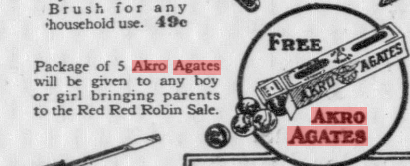
The railroad in this story is the branch line we told you about above and the one shown in the Sanborn map. The boys were 14, 13, 13, and only 9! And again we ponder if Detective White counted all of the recovered marbles and how Akro knew 2,600 were taken? Was this one full crate or box perhaps?
Quick Fact: In 1921 you could buy a box of 11 Akro marbles for 15 cents.
Free Marbles!
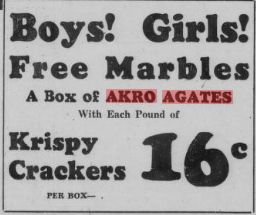
Smyrna Times. [volume], April 11, 1928, Page 6, Image 6
About Smyrna times. [volume] (Smyrna, Del.) 1854-1987
By 1928 Akro Agate was not only a premier marble maker, but it was cashing in on marketing. We have never heard who in the Company may have been in charge of marketing, but note that this free giveaway was in Delaware.
Here’s another one.
The Indianapolis Times. [volume], February 26, 1932, Home Edition, Second Section, Page PAGE 17, Image 17 About The Indianapolis times. [volume] (Indianapolis [Ind.]) 1922-1965
Krispy Crackers were made by Sunshine Biscuits which was founded as Loose-Wiles Biscuits in 1902. And, yes, they sold for 16¢ a pack in 1932! They were very much like our saltine crackers today. We have no idea how many marbles were in a “box” but it seems that when you bought a one pound box of saltines the clerk would give you the marbles.
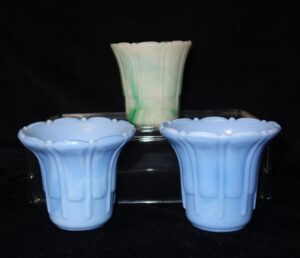
Photograph by Jo Garrett
Akro Agate Diversifies
By the early 1930s Akro diversified into a range of glassware in addition to continuing to make fine marbles.
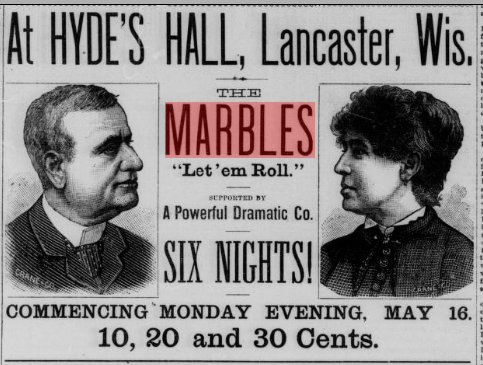 Grant County Herald. [volume], May 12, 1887, Image 1
Grant County Herald. [volume], May 12, 1887, Image 1
About Grant County herald. [volume] (Lancaster, Wis.) 1850-1968
What Was “The Marbles”?
Does anyone have any idea what the Marbles may have been? A traveling troupe of theater actors?
Did they sing and dance; was this some type play? We have no idea, but prices, while reasonable, were not cheap. A dime in 1887 would be worth $3.32 today; next price $6.63; and finally $9.96. Frankly, we hope the 30¢ was a box seat!
Playing Marbles with Diamonds
It is possible that you will dismiss this next story out of hand. We did not find it in the newspaper morgue but we did find it while searching for story ideas. Here we go:
“In 1985, Vance Havner wrote a book titled Playing Marbles with Diamonds. The title of the book emanates from a story that he heard about a traveler who had gone to a poor African village and witnessed an incredible sight. There was a large group of children who were gathered in a circle on the dusty ground playing a game of marbles. As the traveler moved closer, he saw something that absolutely astounded him. These children who had no material possessions were not actually playing the game with glass marbles—they were playing it with diamonds.” [21]
We had never heard of Vance Havner nor the book. You can buy a copy from the Scripture Truth Bookstore for $8.99. The book is about Scripture rather than mibs.
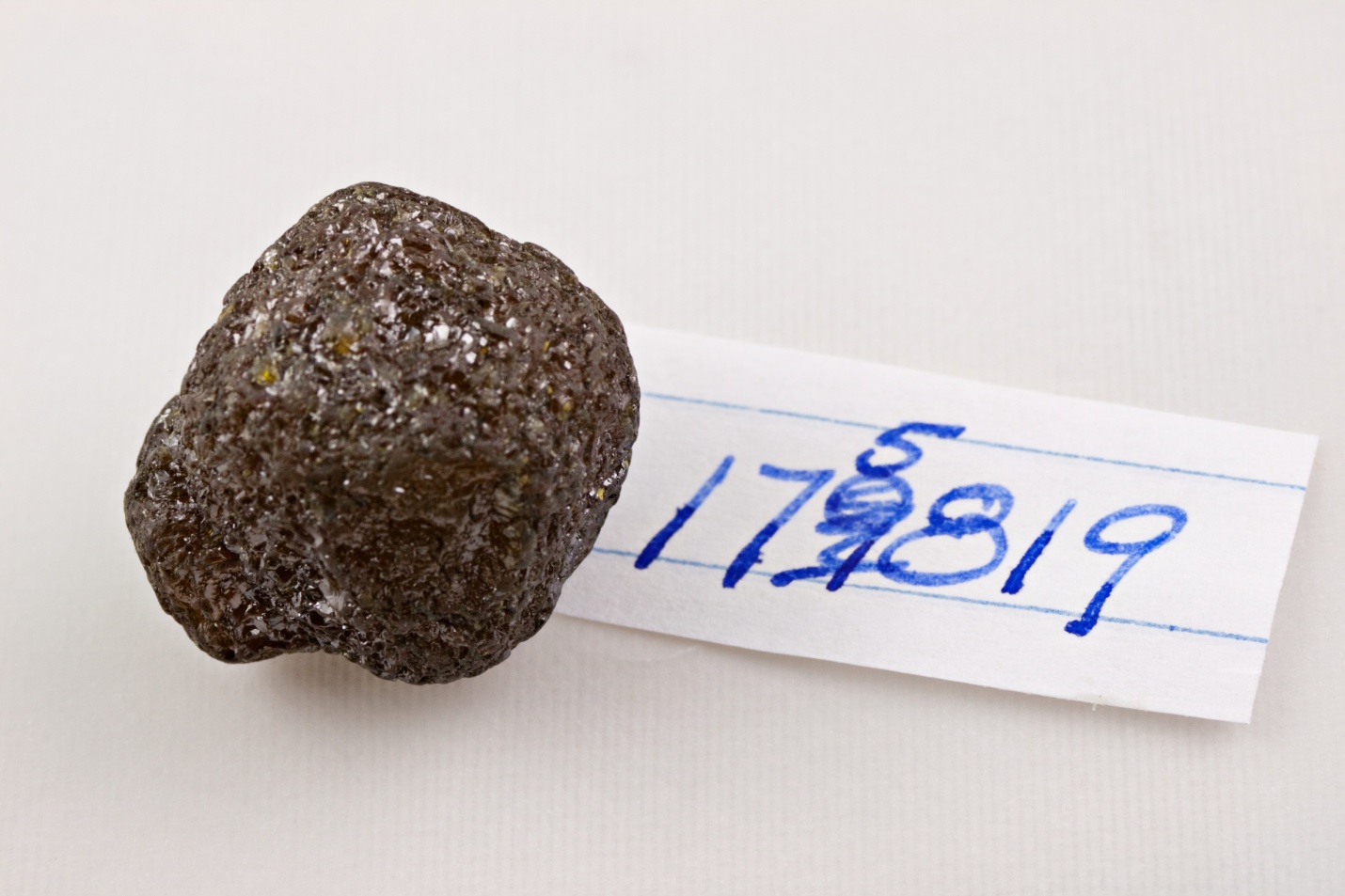
http://n2t.net/ark:/65665/36d4a1d72-925f-4a27-aa97-c786438f8824[22]
This is a fable or moral story meant to convey certain “nuggets of wisdom.” But we got to thinking. We have no doubt that it has been used effectively over the years to convey many and a range of sacred ideas.
Diamonds In The Rough
Is there any possibility this could be an absolutely true account which was adapted into a scriptural story?
Well, first note that there is no definitive place mentioned other than “a poor African village.” We have no idea when the story was said to happen, but in 2024 about one third of Africa’s population or some 429 million people live below the extreme poverty line of $2.15 U.S. dollar a day. About 33% of Africa’s population is in extreme poverty (www.statista.com/). And remember that there have been ongoing and determined efforts to reduce poverty and improve living conditions across the continent.
So, the story could have been written about almost any country on the continent.
The Mineral Science Department at the Smithsonian Institution notes that this diamond is from Kinshasa, the Democratic Republic of the Congo. And these other countries continue to mine diamonds: Botswana; South Africa; Angola; Namibia; Zimbabwe; Lesoto; Sierra Leone; Tanzania; and Guinea.
So, again, the story would fit any number of places in Africa. And look at this raw or uncut diamond! We have dug, found, and even bought marbles less round than this! Honestly, we can imagine some kids finding these in tailings and using this, clay, and other odd orbs to play marbles.
This story should be true. We hope that it is and we also hope that whoever has been using it over the years has found all sorts of morality play to share with others.
King Tut & The Men In Black
Okay, we closed the door to the morgue. But we did find two more brevities while researching which we want to share.
The first clip is about Tutankhamun whom we visited at the National Museum of Egyptian Civilization in Old Cairo many years ago. We’re sure you know that King Tut was only 18 or 19 when he died. He was born about 1341 BCE.
In Chapter One “Where Do Marbles Come From and Why”? of our book The Secret Life of Marbles Their History and Mystery we discuss the discovery of stone marbles inside a tomb in predynastic Egypt. Predynastic Egypt was about 5000 – 3000 BCE. That was a tremendously long time ago for marbles to even exist!
Well, Tutankhamun ruled about 1336 – 1327, which is some 3,000 years after the predynastic Period. And while we have no idea that marbles were found in his tomb since he was older when he died and into “adult toys,” we have found this tidbit about what children must have played with when he was younger: “Toy swords and spears were used emulating male adults. Marbles, darts and bowls were also used in favorite games for boys.”[23]
Can you even imagine any society in which marbles were popular for over 3,000 years? Interest in the game certainly hasn’t lasted that long in any modern culture.
The Men in Black
“This extremely large alien is presumably unknown to humans, possibly even to the Men in Black (MIB). It is known to own marbles, which have what appear to be galaxies within them; one in particular being the Milky Way. The alien, which has a greenish gelatinous appearance and four digits on each hand with its refection showing its face having three bulbous yellow eyes, is seen playing with some of the marbles before packing them in a bag.”[24]
Synchronicity & Galaxy Marbles
We thought that the Men in Black clip was weird enough, but almost immediately after finding it, the synchronicity[25] started. Galaxy marbles started popping up on line while searching for something different entirely. The first site, and probably one of the best that we have seen (so far) is Palmley (https://www.facebook.com/profile.php?id=100093384247784/). We really suggest that you give Palmley a look!
From The Morgue To The Stars
We have closed the morgue door for now. But of course we might come back to it. And we will keep browsing for new ideas.
We do hope that you’ve enjoyed this story as much as we’ve enjoyed knitting it together. And, as always, we invite you to respond on our Comments page about the whole story or any parts of it.
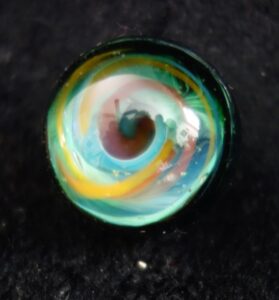
- You can read about James Abbott Whistler (1834 – 1903) @ Whistler Paintings, Bio, Ideas | TheArtStory 11/4/2024 ↑
- https://www.rinse.com/blog/care/how-to-use-mothballs/ 11/6/2024 ↑
- If you want to know why black coal tar turns white after refinement then read “Busting Sealant Myths: ‘Purity’ of Refined Coal Tar” @ Busting Sealant Myths: “Purity” of Refined Coal Tar | Coal Tar Free America 11/6/2024↑
- See Buffalo gnats and how to avoid being bitten | Good Growing | Illinois Extension | UIUC (11/6/2024) ↑
- Orleans County monitor. [volume], April 23, 1900, Image 8 About Orleans County monitor. [volume] (Barton, Vt.) 1872-1953↑
- The Worcester spy. [volume], April 06, 1902, Section A, Page 8, Image 8
About The Worcester spy. [volume] (Worcester, Mass.) 1898-1904 . See https://entomology.ca.uky.edu/ef609 (11/7/2024) for details on the clothes moths. ↑ - The daily telegram. [volume], November 07, 1914, Image 11
- About The daily telegram. [volume] (Clarksburg, W. Va.) 1901-1926
- See Dean Six, Susie Metzler, and Michael Johnson, American Machine-Made Marbles Marble Bags, Boxes, and History. Atglen, PA: Schiffer Publishing Ltd., 2006, “Spiral” page 11; See also Hardy, Roger, & Claudia Hardy Akro Agate Price Guide, Clarksburg: N.p., 1998. ↑
- “The History of the Machine-Made Glass Marble The M.F. Christensen and Son Company and the Akro Agate Company” by Chris Cooper at the American Museum of Glass in Weston, West Virginia, website (The History of the Machine-Made Glass Marble – The Museum of American Glass in West Virginia)↑
- Akro Agate Marbles – History of Akro Agate 11/10/2024 ↑
- e-WV – Glass Sand Mining 11/12/2024 ↑
- HISTORY OF OIL & GAS INDUSTRY ~ The Early Days in West Virginia 11/12/2024 ↑
- https://www.cityofclarksburgwv.com/267/Historical-Facts 11/11/2024 ↑
- If you want to learn a bit more about West Virginia and their marble history check the three stories we wrote after a long trip we made there in 2022: “West Virginia Here d We Come”; (https://thesecretlifeofmarbles.com/west-virginia-here-we-come/); West Virginia Here We Come Part II” (https://thesecretlifeofmarbles.com/west-virginia-here-we-come-part-ii/) and “Road Trip to West Virginia III” (https://thesecretlifeofmarbles.com/road-trip-to-west-virginia-iii/) ↑
- Parkersburg to Clarksburg-Waist of the B&O Main-Part I – WVNC Rails (11/11/2024) You can also check John F. Stover (Mark C. Carnes, Series Editor). The Routledge Historical Atlas of the American Railroads. Routledge, NY, 1999, “Baltimore & Ohio Railroad,” pps. 64 – 65.↑
- Ambos, Nogales: What to know for twin cities sharing US-Mexico border 11/3/2024 ↑
- Roger and Claudia Hardy in their book The Complete Line of The Akro Agate Co., on page IV, list nine Akro colors and they use these colors throughout their book. Note that “pumpkin” and “cobalt” are not on the list! ↑
- Funeral service for Hill @ The Daily Telegram. [volume], April 01, 1916, Image 9
About The Daily Telegram. [volume] (Clarksburg, W. Va.) 1901-1926@ https://library.leeds.ac.uk/special-collections/collection/2157 11/1/2024 ↑ - The Daily Telegram. [volume], May 05, 1916, Page PAGE THREE, Image 17
About The daily telegram. [volume] (Clarksburg, W. Va.) 1901-1926 - ↑Kevin Paul Scott “Don’t Play Marbles with Diamonds” January 15, 2019 @ https://kevinpaulscott.com/dont-play-marbles-diamonds/ 11/1/2024↑
- This photograph is from the Smithsonian Institution’s Mineral Science Department, USNM Number NMNH 175819-00; IGSN ID: 10.58151/NHB007MG0; https://www.si.edu/object/diamond:nmnhmineralsciences_11659725/ 11/15/2024 ↑
- https://www.historyembalmed.org/life-of-king-tut/life-of-tutankhamun.htm (11/1/2024). “The Griffith Institute Tutankhamun: Anatomy of an Excavation The Howard Carter Archives
Photographs by Harry Burton is a list of all the things recovered from Tutankhamun’s tomb. You can read the list and find Tut’s marbles, which we can’t, @ http://www.griffith.ox.ac.uk/gri/carter/ 11/18/2024 ↑ - https://aliens.fandom.com/wiki/Extra-galactic_alien_(Men_in_Black)?file=Look_at_the_Reflection.jpg 11/1/2024 ↑
- You would be amazed at how many hits you get if you search for synchronicity online. If you’re interested in the concept then a good place to start would be Jung. Synchronicity: An Acausal Connecting Principle, by Carl Gustav Jung, is a book published by Princeton University Press in 1960. It was extracted from Structure & Dynamics of the Psyche, which is volume 8 in The Collected Works of C. G. Jung. The book was also published in 1985 by Routledge.↑

